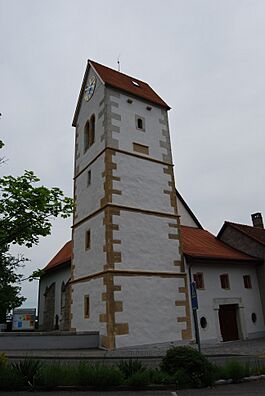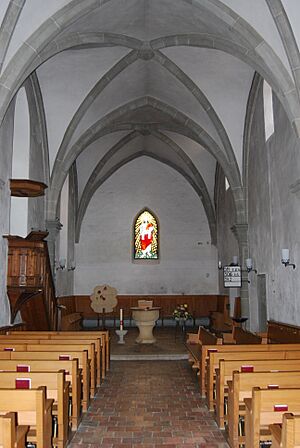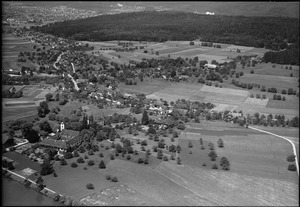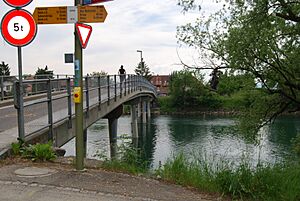Orpund facts for kids
Quick facts for kids
Orpund
|
||
|---|---|---|

Gotthouse Monastery Church in Orpund
|
||
|
||
| Country | Switzerland | |
| Canton | Bern | |
| District | Biel/Bienne | |
| Area | ||
| • Total | 3.97 km2 (1.53 sq mi) | |
| Elevation | 483 m (1,585 ft) | |
| Population
(Dec 2020 )
|
||
| • Total | 3,052 | |
| • Density | 768.8/km2 (1,991.1/sq mi) | |
| Postal code |
2552
|
|
| Surrounded by | Biel/Bienne, Brügg, Safnern, Scheuren, Schwadernau | |
| Twin towns | Brtnice (Czech Republic) | |
Orpund is a town, also called a municipality, in the Bern region of Switzerland. It's part of the Biel/Bienne administrative district. Orpund is located on the left side of the Nidau-Büren channel. It includes the main village of Orpund, the old Gottstatt Monastery, and a small village called Zihlwil.
Contents
History of Orpund
Orpund was first written about in the year 1255. It was called Orpunt back then.
People have lived in this area for a very long time. Tools and items from the Neolithic (New Stone Age), Bronze Age, and La Tène era (an Iron Age culture) were found here. These were discovered when the Nidau-Büren Canal was being built. A collection of Bronze Age items and a Roman-era settlement were also found on Büttenberg hill.
During the Middle Ages, a group called the Counts of Neuchâtel-Nidau built a monastery at Gottstatt. They gave the village of Orpund to this monastery. The village and the monastery shared an island in the Thielle/Zihl river, where they went fishing.
By the late 1300s, the city of Bern took control of the lands around Nidau. Orpund then became part of Bern's area, known as the bailiwick of Nidau. In 1528, during the Protestant Reformation (a big change in Christianity), Gottstatt Monastery was no longer a religious place. Its church became the main church for all of Orpund.
Orpund faced several big fires. On May 8, 1778, eight houses burned down. They were rebuilt, but many still had straw roofs, making them risky. On February 24, 1868, three more houses were destroyed. Then, on May 26, 1868, a huge fire destroyed 26 houses and damaged others. At that time, the whole village only had about 40 houses.
From 1868 to 1875, a big project called the Jura water correction changed the local rivers. The Aare river was sent into Lake Biel, and the Nidau-Büren Canal was built through Orpund. This canal helped drain the Orpundmoos marsh and stopped floods in the village.
Orpund was mostly a farming village until the 1950s. After that, it grew quickly and became a suburb of Biel/Bienne. Many new homes were built in the 1960s. A local school opened in 1970, serving students from Orpund and nearby towns. Today, many people who live in Orpund travel to work in Biel or other cities.
Geography of Orpund
Orpund covers an area of about 4 square kilometers (1.5 square miles). A large part of the land, about 39.1%, is used for farming. Forests cover about 37.4% of the area. About 20.7% of the land has buildings or roads. Rivers and lakes make up about 2.3% of the area.
Most of the forested land is covered with thick forests. For farming, about 30.6% is used for crops, and 7.1% is for pastures where animals graze.
Orpund's Coat of Arms
The coat of arms for Orpund shows a red shield with a golden oar and a golden pike (a type of fish) crossed over each other.
People in Orpund (Demographics)
Orpund has a population of about 2,628 people (as of December 2011). About 15% of the people living here are foreign nationals.
Most people in Orpund (about 86.7%) speak German as their main language. French is the second most common language (6.6%), followed by Italian (1.5%).
In 2008, about 50.1% of the population was male and 49.9% was female. Many people were born in Orpund or in the same canton (region) of Switzerland. About 12.1% of the residents were born outside of Switzerland.
Children and teenagers (ages 0-19) make up about 19.9% of the population. Adults (ages 20-64) are 59.4%, and seniors (over 64) are 20.7%.
The chart below shows how Orpund's population has changed over the years:

Sights to See
The entire Gottstatt Monastery area is a special place. It is listed as an Inventory of Swiss Heritage Site, meaning it's very important to Swiss history and culture.
Orpund's Economy
In 2011, Orpund had a low unemployment rate of 2%. This means most people who wanted jobs had them.
In 2008, there were 747 people working in Orpund.
- About 22 people worked in the primary sector, which includes farming.
- About 426 people worked in the secondary sector. This includes jobs like manufacturing (making things) and construction (building things).
- About 299 people worked in the tertiary sector. This includes jobs in services, like sales, transportation, hotels, education, and healthcare.
Many people who live in Orpund travel to other towns for work. In 2000, about 1,061 people commuted out of Orpund for their jobs. About 537 people came into Orpund to work.
Orpund is home to "claro fair trade." This organization sells products that are made fairly, helping people in other countries.
Religion in Orpund
According to a 2000 survey, most people in Orpund (about 65%) belonged to the Swiss Reformed Church. About 14.5% were Roman Catholic.
Smaller numbers of people belonged to other Christian churches, or to other religions like Islam or Judaism. Some people also stated they had no religious affiliation.
Education in Orpund
In Orpund, about 57.6% of adults have finished high school (upper secondary education). About 15.7% have gone on to higher education, like university.
The school system in the Canton of Bern starts with one year of optional Kindergarten. Then, students go to six years of Primary school. After that, there are three years of lower Secondary school. In secondary school, students are grouped by their abilities. After lower secondary, students can choose more schooling or start an apprenticeship (learning a trade on the job).
During the 2011-2012 school year, 382 students attended schools in Orpund.
- There were 39 kindergarten students.
- There were 148 primary school students.
- There were 195 lower secondary students.
Many students in Orpund's schools have a different first language than the language used in the classroom. Some students are also not Swiss citizens.
See also
 In Spanish: Orpund para niños
In Spanish: Orpund para niños










